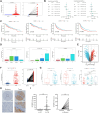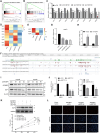Epigenetically associated IGF2BP3 upregulation promotes cell proliferation by regulating E2F1 expression in hepatocellular carcinoma
- PMID: 38992083
- PMCID: PMC11239653
- DOI: 10.1038/s41598-024-67021-w
Epigenetically associated IGF2BP3 upregulation promotes cell proliferation by regulating E2F1 expression in hepatocellular carcinoma
Abstract
RNA-binding proteins (RBPs) are a class of proteins that primarily function by interacting with different types of RNAs and play a critical role in regulating the transcription and translation of cancer-related genes. However, their role in the progression of hepatocellular carcinoma (HCC) remains unclear. In this study, we analyzed RNA sequencing data and the corresponding clinical information of patients with HCC to screen for prognostic RBPs. Insulin-like growth factor 2 mRNA-binding protein 3 (IGF2BP3) was identified as an independent prognostic factor for liver cancer. It is upregulated in HCC and is associated with a poor prognosis. Elevated IGF2BP3 expression was validated via immunohistochemical analysis using a tissue microarray of patients with HCC. IGF2BP3 knockdown inhibited the proliferation of Hep3B and HepG2 cells, whereas IGF2BP3 overexpression promoted the expansion of HuH-7 and MHCC97H cells. Mechanistically, IGF2BP3 modulates cell proliferation by regulating E2F1 expression. DNA hypomethylation of the IGF2BP3 gene may increase the expression of IGF2BP3, thereby enhancing cell proliferation in HCC. Therefore, IGF2BP3 may act as a novel prognostic biomarker and a potential therapeutic target for HCC.
Keywords: E2F1; HCC; Methylation; Prognosis; RNA-binding protein.
© 2024. The Author(s).
Conflict of interest statement
The authors declare no competing interests.
Figures






Similar articles
-
Comprehensive review and updated analysis of DNA methylation in hepatocellular carcinoma: From basic research to clinical application.Clin Transl Med. 2024 Nov;14(11):e70066. doi: 10.1002/ctm2.70066. Clin Transl Med. 2024. PMID: 39462685 Free PMC article. Review.
-
Histone acetylation activated-IGF2BP3 regulates cyclin D1 mRNA stability to drive cell cycle transition and tumor progression of hepatocellular carcinoma.Int J Biol Macromol. 2025 May;306(Pt 3):141678. doi: 10.1016/j.ijbiomac.2025.141678. Epub 2025 Mar 2. Int J Biol Macromol. 2025. PMID: 40037458
-
The m6A reader IGF2BP3 promotes HCC progression by enhancing MCM10 stability.Sci Rep. 2025 Mar 10;15(1):8204. doi: 10.1038/s41598-025-93062-w. Sci Rep. 2025. PMID: 40065065 Free PMC article.
-
FOXM1-activated IGF2BP3 promotes cell malignant phenotypes and M2 macrophage polarization in hepatocellular carcinoma by inhibiting ferroptosis via stabilizing RRM2 mRNA in an m6A-dependent manner.Mol Cell Biochem. 2025 May;480(5):3051-3066. doi: 10.1007/s11010-024-05170-2. Epub 2024 Dec 4. Mol Cell Biochem. 2025. PMID: 39630361
-
Exploring RNA binding proteins in hepatocellular carcinoma: insights into mechanisms and therapeutic potential.J Exp Clin Cancer Res. 2025 Apr 24;44(1):130. doi: 10.1186/s13046-025-03395-7. J Exp Clin Cancer Res. 2025. PMID: 40275278 Free PMC article. Review.
Cited by
-
Comprehensive review and updated analysis of DNA methylation in hepatocellular carcinoma: From basic research to clinical application.Clin Transl Med. 2024 Nov;14(11):e70066. doi: 10.1002/ctm2.70066. Clin Transl Med. 2024. PMID: 39462685 Free PMC article. Review.
-
Global research status and frontiers on ferroptosis in hepatocellular carcinoma: a comprehensive bibliometric and visualized analysis.Front Immunol. 2025 May 2;16:1549600. doi: 10.3389/fimmu.2025.1549600. eCollection 2025. Front Immunol. 2025. PMID: 40386780 Free PMC article.
References
MeSH terms
Substances
Grants and funding
LinkOut - more resources
Full Text Sources
Medical
Molecular Biology Databases

